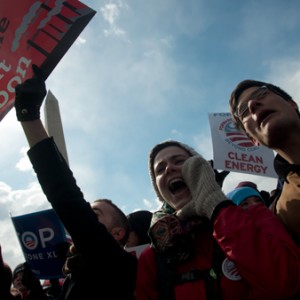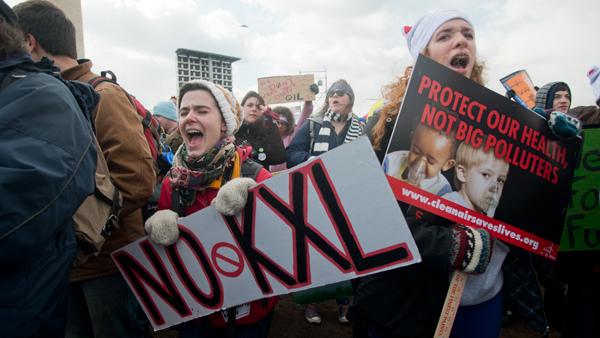In what is being called the largest climate change protest in American history, about 50 Ithaca College students rallied alongside thousands of protesters Sunday in Washington, D.C.
About 35,000 people from across the U.S. traveled to D.C. to protest issues that affect the environment, such as the Keystone XL Pipeline, tar sands oil and fracking.
The Keystone XL Pipeline is a proposed 1,179-mile pipeline that would transport tar sands oil from Canada to the Gulf of Mexico. Tar sands are deposits of loose sand or partially consolidated sandstone that is saturated with viscous bitumen.
Saturday afternoon, six buses left Ithaca for Washington, D.C., two were a combination of Ithaca College, Cornell University and Tompkins Cortland Community College students, one was from Lehman Alternative High School and three were from the Ithaca community.
On the student bus Saturday to D.C., sophomore Dennis Fox, a student from Cornell and treasurer of KyotoNOW!, a student climate action organization, explained what students could expect from the protest.
“There’s going to be a lot of emotion, and we’re going to be doing a lot of good tomorrow, but you should remember especially the world is watching, and you are the face of the environmental movement,” Fox said. “We’re fighting for something that is larger than just ourselves and just Ithaca.”
On Saturday night, students slept in St. Stephen and the Incarnation Episcopal Church with about 150 other people in preparation for the protest Sunday. Some of the student groups that participated were Divest IC and Ithaca College Environmental Society.
By 7 a.m. Sunday, everyone had left the church, and protesters from the college met in front of the World War II Memorial. The group met with other protesters from New York state and chanted phrases like, “Hey hey, ho ho, hydrofracking’s got to go” as they posed for photos by the memorial.
The protest was meant to stress to President Barack Obama how important it is to preserve the environment. Main sponsors of the protest were environmental organizations like Hip-Hop Caucus, the Sierra Club and 350.org.
After Obama made no mention of the Keystone XL Pipeline in the State of the Union Address, activists found it important to encourage him to deny the approval of the pipeline. Prior to the protest Sunday, smaller groups of protesters came to protest on their own, including a group of 48 who were arrested for civil disobedience Feb. 13.
The Keystone XL Pipeline rally is held annually in Washington, D.C. In January 2012, about 12,000 protesters, including 70 from the Ithaca community, formed a chain around the White House. In November 2011, 10,000 protestors supported the cause at the nation’s capital.
Junior Ben Knowles said he is no stranger to the environmental protest scene. He said he has attended four tar sands protests in Washington, D.C., in the past two and a half years to encourage divestment from fossil fuels across college campuses.
“What we are doing on 250 college campuses across the country is a divestment movement,” Knowles said. “We are trying to get our schools to take their money out of fossil fuels, including tar sands production.”
Throughout the rally, many New Yorkers protested fracking, marching and carrying banners like “Our future is unfractured.”
David Braun, regional organizing director for New Yorkers Against Fracking, addressed the screaming crowd at the beginning of the rally. Braun spoke about how proud he was that everyone who came down to D.C. was motivated to make a difference.
“We had to do it and escalate it one step further, so we created the courage to resist hydrofracking,” Braun said.

Despite the wind and temperatures in the low 20s, spirits were high.
Students and protesters waved posters and signs with sayings such as “Suck my pipeline,” “Wake up and smell the methane” and “Your pipe dream is our nightmare.”
Junior Allison Currier, member of Divest IC, said climate change is more than just an environmental issue. She said people involved with building the Keystone XL Pipeline are not adequately informing those affected by the construction.
“This is a social issue,” Currier said. “This pipeline is going to be going through people’s homes, people’s farms, people’s indigenous communities, and transcanada is taking advantage of these people, building pipelines without even telling them what they are getting themselves into.”
One of the speakers was Chief Jacqueline Thomas, past Chief of the Saik’uz First Nation in British Columbia and co-founder of Yinka Dene Alliance, which translates to “People of the Earth.” Thomas spoke about how she is seeing change in the people and land of British Columbia as a result of climate change. She encouraged protesters to do what they think is right and protect the land.
“When we take care of the land, the land will take care of us,” Thomas said. “If we explore our land, we will explore ourselves.”
Susan Multer, a resident of Horseheads, N.Y., said she was at the rally because fracking and climate change are important to her.
“I’m here because I think the planet is in trouble,” Multer said. “If we don’t decrease emissions of greenhouse gases, like CO2 and methane, our survival is at stake.”
In the fall, Multer said she plans to move to Ecovillage in Ithaca, which is a residential community that minimizes impacts on natural systems.
After the speakers finished, around 1:30 p.m, there was a march that followed the route from the Washington Monument, down Constitution Avenue, 17th street, Pennsylvania Avenue, 15th street and back down Constitution Avenue. Protesters then congregated around the Washington Monument for a celebration.
Throughout the march, protesters chanted phrases like, “Hey, Obama, we don’t want no climate drama,” “Tell me what democracy looks like, this is what democracy looks like” and “Bullshit, get off it, enemy is profit, climate devastation will not be bought by corporation.”
Among the protesters wearing everyday clothes were many characters dressed in polar bear costumes to emphasize how climate is affecting the poles. One man was dressed entirely in a suit made of plastic shopping bags.
Unlike Currier and Knowles, who went to the protest as members of groups fighting against climate change, sophomore Chris Carpenter went on the trip, because many members of his family are activists, and he wanted to see what all the excitement was about.
“I heard this was going to be a huge rally and that things were going to be happening, so that’s why I went,” Carpenter said. “It was going to be this historical event, and it was. It was really cool. But, it’s just a matter of time people have and how loud they think their voice is.”
Students at the protest said they wanted to emphasize that government decisions will affect future generations that will be forced to solve those problems.
Currier said the future of clean energy is in the hands of this generation.
“We want to create a clean future that we are proud to be a part of,” Currier said.
Staff Writer Shawn Steiner and Webmaster Charley Bodkin contributed to this report.








